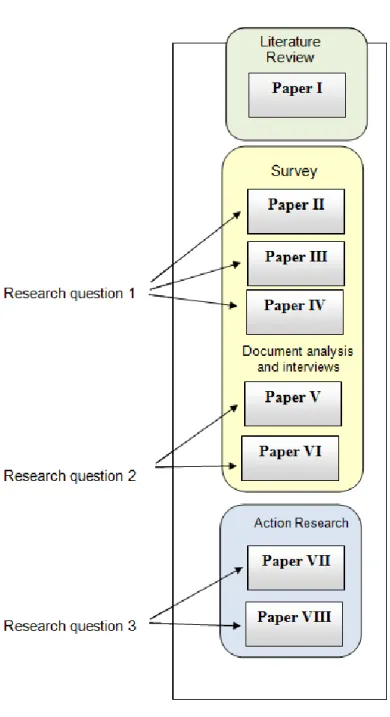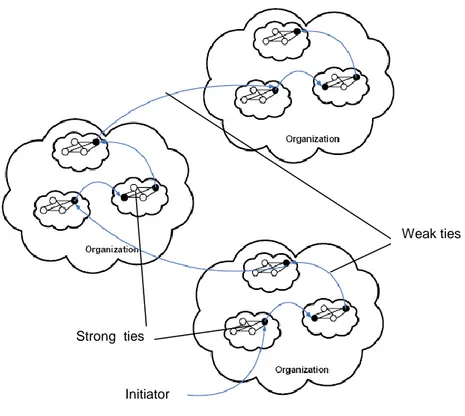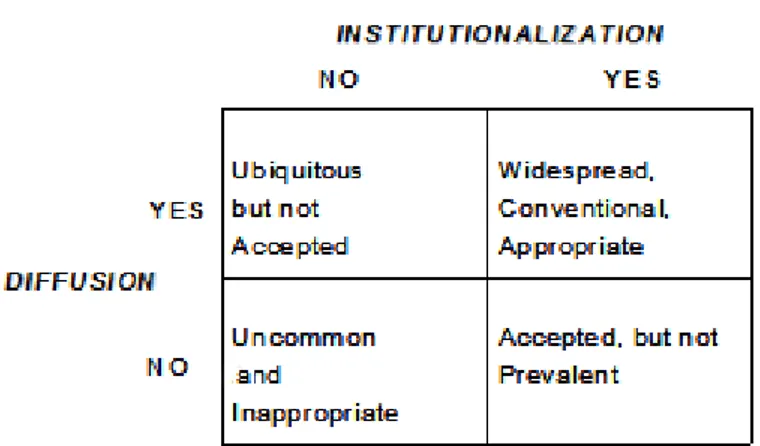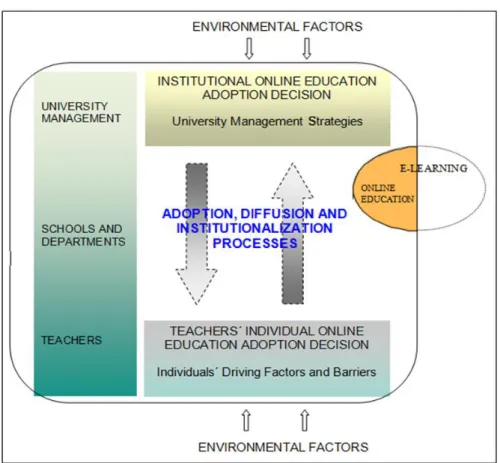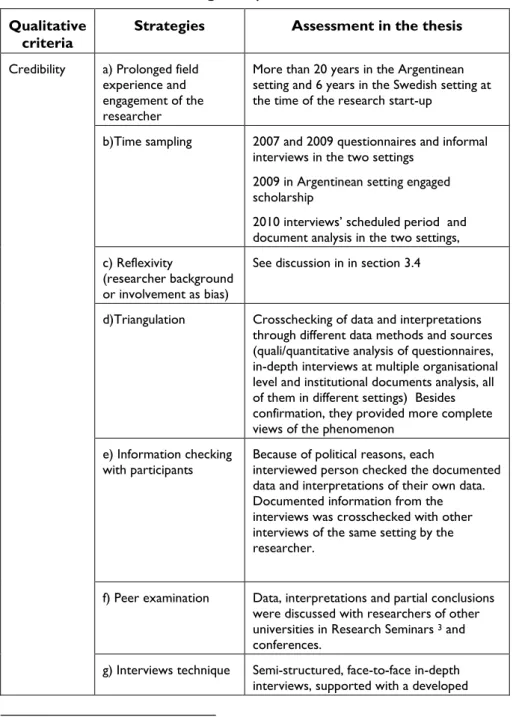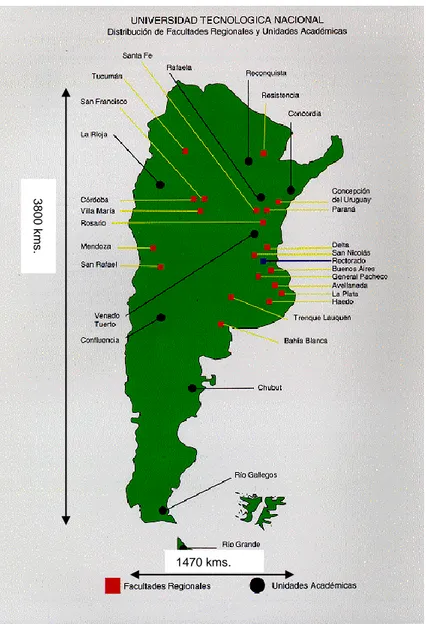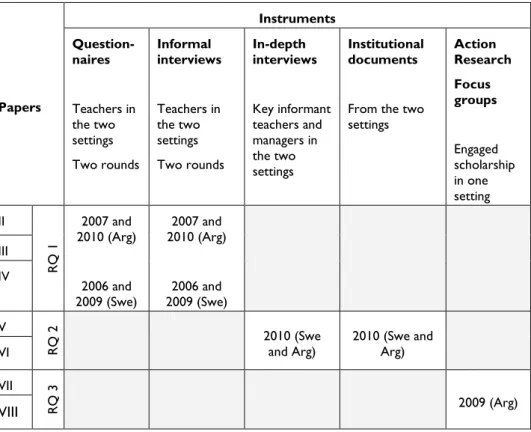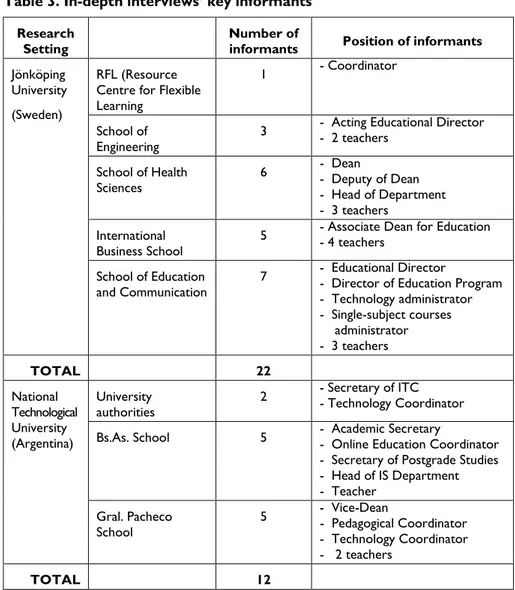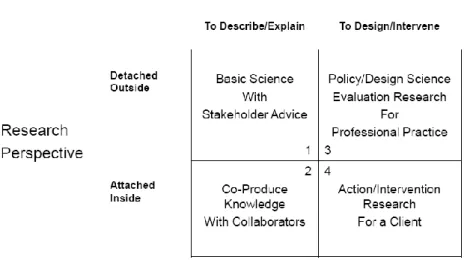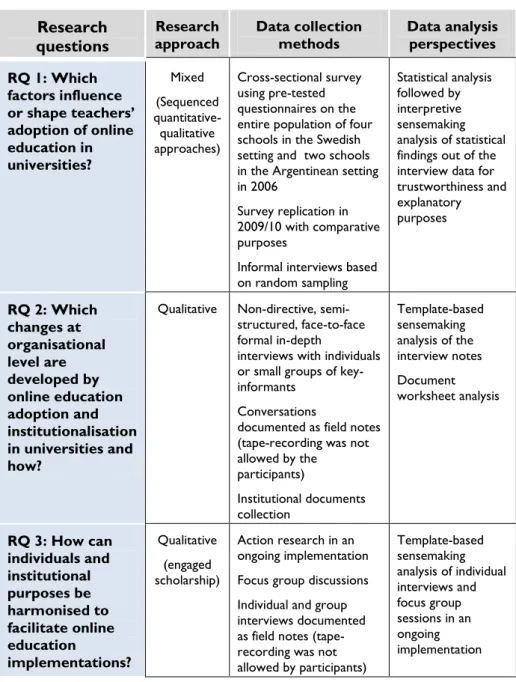This thesis describes and analyses the move from individual adoption to insti-tutionalisation of an information technology innovation: online education in universities. The study focuses on the processes that took place within two uni-versities, one in Sweden and the other in Argentina. The results showed that the adoption processes appeared to be evolutionary rather than revolutionary.
The contributions provide complementary and pluralistic insights into the re-search field of IS, for both theory and practice, as well as into higher education managers’ decision-making. Interactions at macro and micro organisational levels could be modelled as the cyclic linkage between sensemaking outcomes and in-stitutionalised structures. A higher level of theorization resulted in a meta-theory model to describe and explain the linkage itself within the perspective of adaptive structuration theory. Scholar-engaged research allowed conflicting interests to be reconciled by changing the existing practices through sensemaking and negotia-tion among stakeholders in an ongoing implementanegotia-tion.
As an overall conclusion, online education is still far from being fully institu-tionalised. Though the change has not yet become an integral part of the formal core of the institutions, it has been a great achievement considering the universi-ties’ structure, culture and resources. However, there are still key factors that need to be faced. These factors are of a strategic nature and the way to handle them seems to be more political than technological or pedagogical.
Jönköping International Business School Jönköping University
Online Education in Universities
Moving from Individual Adoption to Institutionalisation
of an Information Technology Innovation
JIBS Disser tation Series No . 087 Online Educatio n in Univ ersitie s INÉS C ASANO VAS
Moving from Individual Adoption to Institutionalisation of an Information Technology Innovation
Online Education in Universities
INÉS CASANOVAS
INÉS CASANOVAS
This thesis describes and analyses the move from individual adoption to insti-tutionalisation of an information technology innovation: online education in universities. The study focuses on the processes that took place within two uni-versities, one in Sweden and the other in Argentina. The results showed that the adoption processes appeared to be evolutionary rather than revolutionary.
The contributions provide complementary and pluralistic insights into the re-search field of IS, for both theory and practice, as well as into higher education managers’ decision-making. Interactions at macro and micro organisational levels could be modelled as the cyclic linkage between sensemaking outcomes and in-stitutionalised structures. A higher level of theorization resulted in a meta-theory model to describe and explain the linkage itself within the perspective of adaptive structuration theory. Scholar-engaged research allowed conflicting interests to be reconciled by changing the existing practices through sensemaking and negotia-tion among stakeholders in an ongoing implementanegotia-tion.
As an overall conclusion, online education is still far from being fully institu-tionalised. Though the change has not yet become an integral part of the formal core of the institutions, it has been a great achievement considering the universi-ties’ structure, culture and resources. However, there are still key factors that need to be faced. These factors are of a strategic nature and the way to handle them seems to be more political than technological or pedagogical.
Jönköping International Business School Jönköping University
Online Education in Universities
Moving from Individual Adoption to Institutionalisation
of an Information Technology Innovation
JIBS Disser tation Series No . 087 Online Educatio n in Univ ersitie s INÉS C ASANO VAS
Moving from Individual Adoption to Institutionalisation of an Information Technology Innovation
Online Education in Universities
INÉS CASANOVAS
INÉS CASANOVAS
Online Education in Universities
Moving from Individual Adoption to Institutionalisation
of an Information Technology Innovation
P.O. Box 1026 SE-551 11 Jönköping Tel.: +46 36 10 10 00 E-mail: info@jibs.hj.se www.jibs.se
Online Education in Universities: Moving from Individual Adoption to Institutionalisation of an Information Technology Innovation
JIBS Dissertation Series No. 087
© 2013 Inés Casanovas and Jönköping International Business School
ISSN 1403-0470
ISBN 978-91-86345-40-2
This thesis describes and analyses the move from individual adoption to institutionalisation of an information technology innovation: online education in universities. The study focuses on the processes that took place within two universities, one in Sweden and the other in Argentina, regarding online education adoption and the organisational changes developed.
The aim is to contribute to the understanding of individual and organisational strategies for the institutionalisation of the innovation. To achieve this aim, three research questions were posed. The first focused on the way in which teachers influence the adoption processes. The next addressed the changes and interactions at the individual and institutional levels resulting from these processes. The third question deepened into the methodological practices that can harmonise stakeholders‟ objectives and the conflicting interests regarding online education initiatives. Innovation theory, complemented with organisational theories provided the foundation for the description and analysis of the information technology innovation and the adoption processes.
The results of analysing and interpreting the collected data from the two universities in two different countries (Sweden and Argentina) showed that the adoption processes appeared to be evolutionary rather than revolutionary. The iterative nature of the appropriation and the constant “newness” of the information technology innovation may be plausible explanations for the phenomenon. Though the change has not yet become an integral part of the formal core of the institutions, it has been a great achievement considering the universities‟ structure, culture and resources.
The contributions provide complementary and pluralistic insights into the research field of Information Systems, for both theory and practice, as well as into higher education managers‟ decision-making. Furthermore, the knowledge contribution of the thesis could be applied to implementation of information technology innovations in other organisations with similar characteristics as the studied higher education institutions. Such characteristics are, for example, to be complex and knowledge intensive.
Interactions at macro and micro organisational levels could be modelled as the cyclic linkage between sensemaking outcomes and institutionalised structures. A higher level of theorization resulted in a meta-theory model to describe and explain the linkage itself within the perspective of adaptive structuration theory.
Regarding practice, scholar-engaged research allowed conflicting interests to be reconciled by changing the existing practices through sensemaking and negotiation among stakeholders in an ongoing implementation. As an overall conclusion, online education is still far from being fully institutionalised. After four years of technological and contextual changes during the research development, a positive shift can be seen in teachers‟ attitude towards online
virtual environments. Nevertheless, there are still key factors that need to be faced regarding online education adoption and institutionalisation. These factors are of a strategic nature and the way to handle them seems to be more political than technological or pedagogical.
Acknowledgments
Once upon a time, more precisely on 11 February, 2007, four of my dearest Swedish friends, Mats-Åke, Jörgen, Mats and Carita, were sitting in Mats-Åke‟s home, by the swimming pool, enjoying a coffee and encouraging me to make one of my most challenging decisions: to take up doctoral studies. Thanks and ever thanks…
Jörgen Lindh was so enthusiastic that he became one of my supervisors, and he undertook the task bravely, even during the short time when his health weakened. Christina Keller and Stefan Hrastinski, dear friends too, joined the team as associate supervisors. The three of them gave me advice and encouragement when I needed ….and very happy moments when I was staying in Sweden. They believed in me; without their support, I would never have succeeded. Specifically worth mentioning is the support from Sven Carlsson. Thanks for the valuable advice during my final seminar.
I am grateful to the Department of Informatics in Jönköping. There, I met a group of colleagues who gave me not only intellectual but emotional support. Thanks to Susann Anderson, Ewa Bewing, Kerstin Ferroukhi, Peter Hilton, Britt-Marie Johansson, Ulf Larsson, Stefan Nylander, Carol-Ann Soames, May Wismen…The coffee breaks with „semlor‟ on Fridays are unforgettable. Sincere thanks to Daniela and Marius Mihailescu. They made me feel „at home‟.
I will not forget to thank Susanne Hansson and Monica Bartels for their kindness and help with administrative issues, and all the participants in my empirical studies who contributed patience and time during the four years of the research.
Sincere thanks also to my Argentinean colleagues and friends. They accompanied me all the time and helped with my duties when I had to work in Sweden.
I reserved the closing paragraph to thank the most important persons in my life: my family. They encouraged me to undertake the challenge and for five years, they patiently and lovingly supported my effort. I missed all of you so much when I had to be far from you for so long!
Buenos Aires, November 2012 Inés Casanovas
1 Introduction ... 13
1.1 Online education and Information Systems (IS) research ... 15
1.2 The literature review about adoption and institutionalisation of ... online education in universities ... 16
1.2.1 Prior reviews ... 17
1.2.2 Review design ... 18
1.2.3 Summary of the review (Paper I) ... 19
1.3 Aim and research questions ... 20
1.4 Structure of the thesis ... 22
2 Theoretical background ... 26
2.1 Conceptual issues about online education... 27
2.1.1 From e-learning to online education ... 27
2.1.2 The status of online education ... 28
Key contributions to the thesis ... 31
2.2 Online education as innovation ... 32
2.2.1 Reviewing the concept and models of innovation: a historical and theoretical approach ... 32
Key contributions to the thesis... 34
2.3 The institutional context: universities ... 34
2.3.1 Universities as learning organisations ... 37
Key contributions to the thesis ... 39
2.4 The institutional environment: Sweden and Argentina ... 39
2.4.1 Swedish national governmental policies for ICT-based education ... 40
2.4.2 Argentinean national governmental policies for ICT-based education ... 43
2.4.3 Similarities and differences between Sweden and Argentina„s policies regarding ICT-based education ... 47
2.4.4. The role of culture in IS adoption in different geographical settings ... 48
models ...51
2.5.1 The sequential model founding theories ...51
2.5.2 The networked models ...53
2.5.2.1 The networked grassroots diffusion model ...54
Key contributions to the thesis ...57
2.6 Institutionalisation of change as a multilevel ongoing process ...58
Key contributions to the thesis ...60
2.7 Relating individual technology innovation adoption and organisational theories ...61
2.7.1 The organisational macro-level and the contextual constraints: Institutional theory ...62
2.7.2 The organisational micro-level: individuals‟ sensemaking ...63
2.7.3 Linking macro and micro-level interactions ...65
2.7.4 The production and reproduction process: Structuration Theory as a meta-theory ...65
2.7.5 Including IT: the Adaptive Structuration Theory ...67
Key contributions to the thesis ...70
2.8 To sum up: a pluralistic and complementary framework to explore a complex scenario ...71
3 Research approaches ...74
3.1 The interpretive approach ...74
3.2 The goals of theory ...75
3.3 A mixed methodological approach ...76
3.4 Choosing the style of the researcher ...80
3.5 Working in different countries: the research settings ...81
3.5.1 Jönköping University (JU) ...82
3.5.2 National Technological University (UTN) ...83
3.6 Data collection and analysis ...85
3.7 The survey questionnaire ...86
3.7.1 Questionnaires analysis ...88
3.8 In-depth interviews ...89
3.8.1 Interview analysis ...93
3.10 Working in collaboration with the stakeholders ... 99
3.10.1 Action Research ... 101
3.11 Summary ... 104
4 Summary of the Papers ... 106
Paper I: Exploring the current theoretical background about adoption to the institutionalisation of online education in universities: needs for further research ... 106
Paper II: Professors‟ driving and limiting factors for the adoption of e-learning in Higher Education within Argentine context ... 106
Paper III: Teachers‟ perception of institutional strategies in e-learning implementations: a comparative study of an Argentinean and a Swedish university ... 107
Paper IV: The impact of national culture on e-learning implementations: a comparative study of an Argentinean and a Swedish university ... 108
Paper V: The impact of communicating institutional strategies in teachers‟ attitude about adopting online education ... 108
Paper VI: Institutional strategies influencing the adoption of online education in universities ... 109
Paper VII: Flexibility to harmonise teachers and institutional stakeholders‟ purposes of e-learning initiatives ... 109
Paper VIII: An experience of an engineering online education implementation involving action research ... 110
5 Concluding discussions ... 111
5.1 Theoretical implications ... 114
5.1.1 From complementary theories to a meta-theory ... 115
5.1.1.1 Sensemaking and organisational learning ... 115
5.1.1.2 Sensemaking and Institutional theory ... 116
5.1.1.3 The umbrella of a meta-theory ... 119
5.2 Implications for practice ... 122
5.3 Limitations and further research ... 123
Appendix A Related publications ... 156
Appendix B: List of reviewed articles in Paper I - Extended concept matrix ... 159
Appendix C: 2006/2007 Questionnaire template ... 167
Appendix D: 2009/2010 Questionnaire template ... 173
Appendix E: Swedish setting interviews analysis matrix ... 179
Appendix F: Argentinean setting interviews analysis matrix... 188
Appendix G: Document list and analysis template ... 198
Collection of Articles and Papers ... 201
Paper I Exploring the Current Theoretical Background About Adoption to the Institutionalisation of Online Education in Universities: Needs for Further Research ... 203
Paper II Professors‟ driving and limiting factors for the adoption of E-learning in higher education within the Argentine context ... 225
Paper III Teachers‟ perception of institutional strategies in e-learning implementations: a comparative study of an Argentinean and a Swedish university ... 239
Paper IV The impact of national culture on e-learning implementation: a comparative study of an Argentinean and a Swedish university ... 255
Paper V The impact of communicating institutional strategies on teacher‟s attitude about adopting online education ... 275
Paper VI Institutional strategies influencing the adoption of online education in universities ... 295
Paper VII Flexibility to harmonise teachers and institutional stakeholders‟ purposes of e-learning initiatives: a pilot experience... 319
Paper VIII An experience of an engineering online education implementation involving action research ... 333
List of Figures
(Figures in papers are not included)
Figure 1. Relations among the research questions and the papers ... 23
Figure 2. Grassroots diffusion model ... 56
Figure 3. Matrix comparing diffusion and institutionalisation ... 59
Figure 4. The research scenario ... 73
Figure 5. Distribution of UTN schools throughout the country ... 84
Figure 6. Alternative forms of engaged scholarship ... 100
Figure 7. Action Research Model ... 102
Figure 8. The research theoretical lenses ... 113
Figure 9. Cyclic linkage between Sensemaking and Institutional theories within the university environment ... 117
Figure 10. AST as an explaining meta-theory for the complementary linkage of the sensemaking and institutional theories. ... 120
List of Tables
(Tables in papers are not included)
Table 1. Summary of criteria and strategies to establish qualitative research trustworthiness of the thesis ... 78Table 2. Instruments used in each paper and actual time of development, related to Research Questions ... 86
Table 3. In-depth interviews‟ key informants ... 91
Table 4. Research frame summary ... 105
1 Introduction
This thesis focuses on the processes that took place within universities regarding online education adoption and the organisational changes it has developed, examining individual and organisational meanings and strategies for the institutionalisation of the innovation.
Online education is understood in this thesis as the use of online technologies in formal higher education for teaching and learning (Allen & Seaman, 2010). Individual adoption can be seen as a definable single decision act, while at organisational level adoption is viewed as a series of complex, continually evolving and contingency decisions process (Frambach & Schillawaert, 2002; Martin & Beimborn, 2007; Rogers, 2003). Following Colyvas and Jonsson (2011) perspective, institutionalisation is considered in this work as a dynamic and ongoing process as well as an outcome state, representing practices and structures across and within organisations.
Although the teachers and the institutions have been studied in Management and Education research domains, this work analyses the relationships that enable the transfer of the adoption of learning innovations between individual teachers and the formal organisational system as interlinked and interacting. Informal networks are important in spreading innovations but they cannot substitute formal organisational structures and priorities (Russell, 2008).
In 2006, a survey was performed to study the individual and institutional factors of online education initiatives in two settings. It was framed in a joint research between the National Technological University of Argentina and Jönköping University, JIBS of Sweden. The initial findings became the basis of this work and motivated a more in-depth study of the adoption of online education and the institutionalisation process in both environments. With an open and integrative research perspective, the interrelated effects of individual, institutional and contextual influences were explored and described.
“Higher education has always been international in scope…”. However, the
emergence of a global market in higher education “poses a potentially serious threat
to the academic mission of institutions” (OECD, 2006, p. 4). The challenge is a
Higher Education system serving the whole society more broadly by taking on the responsibility for continuous development. Along the same line, Soares et al. (2007) held that competition in the market of Higher Education has pushed universities towards the adoption of more sophisticated organisational practices including the use of technology, quality and flexibility to ensure effectiveness.
Castells (2001) asserted that ICT‟s are the infrastructure of the Knowledge Society and the Internet the convergent technology. The skill to design or redesign education as an answer to these transformations is the key to
positioning in this society (Schiavo, 2006). Educational institutions have to change according to the emerging scenarios of each country.
Online education implementations in university contexts mean new organisational challenges. The transition from on-campus learning to virtual learning evolves new roles, both in the pedagogical and in the administrative domain. Many traditional non-profit institutions are slowly becoming involved in online programmes. They have been defined as extended traditional universities (Latchem & Hanna, 2001), operating as the parent organisations to full virtual programmes or blended modalities.
Furthermore, the European Commission strategic framework for education and training (European Commission, 2006), fostered lifelong learning policies through the promotion of innovation, multilingualism and the adoption of ICT. The Commission stated that embedding ICT in education requires further changes across the technological, organisational, teaching and learning environments by means of innovative organisational approaches. ICT has not yet transformed teaching and learning environments as it has transformed processes in other key sectors such as enterprise or public services (European Commission, 2008). There are many examples of effective learning innovation but there are still concerns about the spreading of newly adopted learning technologies. “There is a continuing need to identify, promote and support good practice and
models of change to produce sustainable change [in formal education]” (Underwood, 2009,
p. 24)
This new institutional model is unbundling traditional functions and roles as online education rarely fits into the existing university structure (Inoue, 2006). Needs for new management strategies and governance structures are emerging at institutional and departmental levels in addition to clear and comprehensive strategies for the integration of e-learning into their educational processes (Boezerooij, 2006; Perkinson, 2006).
Institutions have recognised the overall impact and the need for change in recent years. The fact that universities need to change in order to accommodate the impact of technology on learning is already known and accepted (Ben Youssef & Dahmani, 2010; Department for Education and Skills, 2003; European University Association, 2003; Jones & O‟Shea, 2004; Weller, 2011). However, coping with change still represents a management challenge for universities adopting e-learning.
Salaman and Storey (2002) reported a lack of explanations of the managerial processes contributing to innovativeness and the factors and processes involved in its achievement. Since the time of the reported lack of studies, students and teachers have fostered the use of more technology every day. However, the institutional strategies supporting the adoption need to be considered critically (Woo, 2006) and the complementary organisational design is still slow and differs among institutions (Ben Youssef & Dahmani, 2010).
The evolutionary process of educational innovation that universities are carrying out can be examined as an interlinked whole of actors‟ interactions.
The obstacles to organisational change cannot be understood, nor can strategies for implementing change be developed without considering and analysing academic practices and interactions (Jaffee, 1998). Massini and Pettigrew (2004) reinforced the need to identify these interdependencies.
The disconnection between individual and organisational IT (Information Technology) adoption research has been largely remarked by academic researchers (Bohorquez, Lopez & Esteves, 2010; DIGIT, 2004; Greenhalgh et al., 2005, Martin & Beimborn, 2007).Correspondingly, other authors have claimed for a better understanding of this linkage (Jeyaraj et al., 2006; Middlehurst, 2003). In the Sloan National Commission on Online Learning‟s report (2009), the disconnection between the strategic level and the current level of utilization of online learning was fully recognised. The Sloan report poses questions about the distance between the individual and the organisational levels, the lack of information about strategies, the imperceptions of faculty attitudes, and the request for studies to help universities managers, among other issues related to online learning implementation.
This reported state of knowledge leads to the belief that teachers‟ individual influences in the processes of adoption and institutionalisation as well as the institutional culture and external factors have been understudied within the perspective of cyclic interactions among multiple organisational levels in the particular context of universities. The fragmented models developed do not capture and explain why teachers and managers make different meanings when facing the innovation and the institutional environmental constraints. In addition to a general contribution to online education research in universities and the process involved in its adoption and institutionalisation within the IS field, a literature review was performed to verify the research needs regarding key topics and approaches in the research field (see section 1.3). The systematic exploration allowed Research Question 1 and 2 of this thesis to be formulated.
1.1 Online education and Information
Systems (IS) research
Since early on, the focus and scope of the IS research field has been a matter of debate among researchers. Keen (1987) defined its mission as the study of the design, delivery use and impact of information technologies in organisations and society. Since then, new topics have emerged, widening the field scope and the IS field has fully emerged as a discipline in its own right (Baskerville & Myers, 2002). Because of its multidisciplinary base, diversity of problems has been addressed by a pluralistic cumulative literature, helping to shed light regarding what IS is and is not.
This fuzziness of boundaries, according to several authors (see for example Hirschheim & Klein, 2003) flexibilises the inclusion of topics studied in the field. The IS research community moved away from Keen‟s technical scope to focus more on behavioural issues. IS studies information technology within an organisational context (Galliers & Wendy, 2011), being receptive to interdisciplinary action and critical research, and embracing diverse research interests (Klein & Hirschheim, 2008).
Moreover, Du Plooy (2003a) suggested that information systems are best understood when viewed as social systems. There is a social responsibility (Du Plooy, 2003b) in IS development because the adoption and use of new technologies change organisations.
Both e-learning and IS are focused on the best use of information technology within a social setting, being online education a particular type of IS used in the specific formal context of higher education institutions.
The integration of the different theoretical perspectives and the interdisciplinary research field of Educational Technology has been challenging IS researchers. IS has changed education. Institutions and students use Internet-based systems for the distribution of material and communication. It has also fostered new structures in higher education institutions realigning strategies in response to changes in technology (Agarval & Lucas, 2005). Along the same line, other researchers recognise the validity of viewing e-learning research within the IS field in the sight of the common goal of harnessing new educational technologies to meet the needs of their users (Holsapple & Lee-Post, 2006)
1.2 The literature review about adoption
and institutionalisation of online
education in universities
“A review of prior relevant literature is an essential feature of any academic project. An effective review creates a firm foundation for advancing knowledge…” (Webster & Watson,
2002, p. xiii) uncovering topics in which research is needed. According to Sandberg and Alvesson (2011), gap-spotting is the predominant way of generating research questions. Researchers pose their questions by identifying specific gaps in the existing literature that need to be filled.
Although the literature is growing, organisational issues regarding the adoption and institutionalisation of e-learning represent a small proportion of the published IS literature. The lack of studies focusing on the analysis of technology-mediated learning adoption at organisational level was noted early on by Alavi and Leidner (2001) and the scarce exploration of the role of organisations in facilitating and supporting organisational knowledge creation
has been recently reported by Alipour et al. (2011). Furthermore, in the track IS Curriculum and Education, of the International Conference on Information Systems 2011, the topic Integration of Technology and Education called for research works.
1.2.1 Prior reviews
Dwivedi et al.‟s (2008) report listed 134 articles from the period 2005-2007, related to adoption and diffusion in IS are listed. The major number of articles was published in Information and Management, Communication of ACM, Journal of Computer Information Systems, MIS Quarterly, and European Journal of Information Systems (review of top-ranked journals). Conference papers were not included. These journals, according to that study, showed a decreasing tendency in the number of related articles. Agreeing with Dwivedi, most of them focused their analysis on technology acceptance (e.g. Benbasat & Barki, 2007; King & He, 2006; Schwartz & Chin, 2007; Silva, 2007; Venkatesh et al., 2007). None of these articles addressed universities or higher education institutions as the context for the adoption of IT innovations1. Palvia and
Pinjani (2007) confirmed this orientation.
Hrastinski (2007) and Hrastinski and Keller (2007), remarked on the importance of technology-mediated learning in IS research and Educational Technology as an extension. They reviewed articles published in Computers & Education, Educational Media International, Journal of Educational Computing Research and Journal of Educational Media. According to their findings, most of the articles referred to empirical experiences of projects or courses and e-learning theories and frameworks, mainly relying on quantitative methods measuring learners and teachers‟ attitudes towards educational technologies, their impact and their extent of use. The remaining studies fell into qualitative and mixed research approaches focusing on conceptual-analytical design and the evaluation of learning environments.
To the best of my knowledge, the reviews mentioned are the most closely related to this research domain, but they do not focus specifically on it. Initially, educational and organisational journals were included in the review. However, during the data collection it became clear that the latter had published too few relevant articles. Thus, their contribution to enlightening related trends of research was not significant in relation to the effort involved. Therefore, taking into account these previous reviews and the aim of this work, it appeared more fruitful to study conference proceedings and journals specialised in education in which much more relevant articles were published.
1.2.2 Review design
Because literature reviews are time-consuming, and according to Webster and Watson (2002), journal databases accelerate the identification of relevant articles, the following databases were consulted: ABI/INFORM, Business Source Premier, Emerald, JSTOR, Sage Journals, Science Direct, Scirus, Social Science Citation Index, and Springerlink. Webster and Watson also recommended not focusing on small samples of journals and examining selected conference proceedings in addition.
Nevertheless, these researchers argue that sometimes articles are missed, because the keyword sieve does not catch them. Thus, manual indexing and content review were performed as well. Critical analysis to establish differences and convergences of perspectives enabled the confirmation of the emergent research questions for the thesis.
The search period was established as 2005 to 2008. A total of 42 journal articles and 11 international conferences papers were found and their relevance confirmed through crosschecking (results of the search-engine/manual text analysis).
The analysis framework was adapted from Gregor‟s (2006) model and it is intended to reveal those research topics addressed in Educational Technology general research. During the examination of the articles, the need for a concept matrix soon arose. “A high quality review focuses on concepts” (Webster & Watson, 2002, p.xv). Accordingly, the review is concept-centric regarding the organizing frame.
Guided by Webster and Watson‟s (2002) work, extended concept matrices involving topics, methodologies, methods, and level of analysis were developed. According to Klopper et al. (2007, p. 272), “by using key concepts derived from the
problem statement, the problem statement itself becomes the filter that ensures that only literature relevant to the problem under investigation forms part of the review”. The selected
terms: online education, universities, adoption and institutionalisation are discussed in depth in Chapter 2.
However, during the initial search phase it could be stated that several terms were used synonymously with online education in the research literature: e-learning, technology-mediated e-learning, online e-learning, Internet-based education, web-based learning and virtual learning among others. Consequently, broader consideration was required by including those terms in the search and performing text analysis of the full papers in the set of results to keep the selection of articles on the focus, confirming its relevance.
The same situation led to the broadening of the search terms referring to the processes, and the following terms were considered: adoption/transition/ transformation/intention/use/acceptance/dissemination/embedding/institutio nalisation/technological innovation/technological change/technological integration/institutional change. Text analysis of the full papers in the result
report was also required to maintain the focus of the selection of articles and confirm its relevance.
In Appendix B, the matrix used to summarise the most frequently used terms or constructs to define the innovation object and the structuration processes is detailed.
The results of the literature review were published in the Electronic Journal of E-learning (see Paper I). An earlier version of this article was included in the Proceedings of the 8th, European Conference on E-Learning (ECEL 2009),
124-131.
1.2.3 Summary of the review (Paper I)
In this paper, it is argued that summarising and categorising the recent research in the field of adoption and institutionalisation of online education in universities might be fruitful to identify gaps and uncover priorities, validating the research questions of the thesis.
The findings were classified according to several dimensions (by journal/conference, year, level of analysis, methodological approach, research methods, and frequently used terms). The scope of the review was broader than the findings needed for this work. They are presented in full in paper I. I will focus here on the topics relevant to the research questions.
The figures show that the number of articles on adoption in university contexts published in specialised journals and conferences is constantly increasing, with significant growth between 2006 and 2007 of approximately 90%, revealing the interest of research. Interest in the adoption of e-learning in China, the Far East, the Middle-East and Africa as emergent countries is revealed in the presence of articles and papers in the selected journals and conferences during the explored period and it is still growing. As the e-learning market is demanding investments for new implementations, it is reasonable that theoretical knowledge and reported experiences are required.
Through full text reading and analysis it was possible to identify the level at which adoption has been studied. Adoption at individual level of analysis refers to articles in which perceptions of individuals regarding the attributes of the innovation or benefits, users‟ intention of adoption, influence of colleagues, individual drivers and barriers to adoption, e-learning tools informally used by faculty, attitudes, etc. are discussed.
Studies about adoption at individual level but within organisations have analysed the variance of adoption based on institutional characteristics, individual attitudes towards the institutional transformation because of learning adoption, individual attitudes towards the quality of institutional e-learning programmes, transformation of teaching practices, faculty‟s discussions about institutionalisation, teachers‟ perception of institutional strategies, drivers and barriers, etc. At organisational level, studies have referred mainly to reported experiences of implementations in universities, prescribing models of
best practice and critical success factors, or financial and administrative issues of e-learning planning.
None of the articles reviewed explored the entire process from adoption to institutionalisation, confirming the reported disconnection between individual and organisational IT adoption research.
The online education concept appears to have been used often as a research paradigm under the umbrella of the e-learning concept. However, in some works, the term was clearly identified and defined as the use of online technologies in formal higher education for teaching and learning, coinciding with the definition adopted in this thesis.
Regarding the terms related to the process, results showed that in spite of the great variety of terms used interchangeably in the research field, the term most frequently used continues to be adoption, coinciding with Dwivedi et al.‟s (2008) findings. This can indicate the focus of researchers on the decision-making and not on the institutional process.
Some limitations have to be considered regarding these findings. The search results belong to a very special domain of journals involved in the theme, so the number and sample of identified and analysed articles can be arguable. To the best of my ability, the review was systematic and comprehensive, involving full text analysis of the papers to identify the relevance of the articles because most frequently, the search terms did not appear in the title or keywords.
The results served for reflection about the current state and further needs of research in general and in particular domains of the review. The fact that the process from online education adoption at individual level to institutionalisation and the linkage between individual and organisational purposes have scarcely been studied encourages the proposal of interpretations to clarify these issues.
In addition, a new and quick run-through the literature published after this review was performed to extend the review in time and detect changes in the topics or perspectives addressed regarding the adoption and institutionalisation of online education in universities. In accordance with Hardaker and Singh (2011, p. 223), “there is a shift in innovation research from solely macro and micro level
perspectives towards a more interactive view, which emphasises the interactions and interconnections between individual actions and structural influences…Nevertheless, there is a need for explanatory frameworks that take into account both micro and macro perspectives”.
In addition, Graham et al. (2012, p. 8) pointed out that “the boundary between
adoption/early implementation and mature implementation/growth is fuzzy. Research could investigate the specific processes and interventions that successful institutions use to institutionalise blended learning”.
1.3 Aim and research questions
A literature review (Paper I) was conducted in the earlier stages of the work, providing an overview of the research approaches and main issues studied in
the field of online education in universities addressing its adoption and institutionalisation. Results led to the perception that online education is still in the initial states of integration into universities.
The aim of this research is to contribute to the understanding of the current adoption and institutionalisation strategic processes in the Argentinean and Swedish complementary research settings, from the perspectives of both teachers and managers. The study examines the processes that take place within the university domain regarding online education adoption, the interactions among organisational levels, and the resulting organisational changes.
The results from the literature review underlay the two research questions addressing the gap identified between the individual and the organisational level in the adoption of innovations.
The individual factors influencing or shaping the adoption of online education at teachers‟ level within the university institutional environment were examined in Research Question 1. Factors such as the attitudes, purposes and perceptions of teachers in two contexts, an Argentinean and a Swedish university, were studied through a double survey, and results were analysed and interpreted.
Research question 1: Which factors influence or shape teachers’ adoption of online education in universities? (Papers II, III and IV)
Having stated teachers‟ influences in the adoption of online education at individual level, the research connects the individual adoption with the organisational domain, in which institutional influences and changes take place complementarily.
Research question 2 identifies these systemic changes using institutional documentation and interviews with teachers. The results describe the adoption and institutionalisation processes and how they are developed in both research settings as interlinked processes, contributing to the understanding of the disconnection between individual and organisational IT adoption.
Research question 2: Which changes at organisational level are developed by online education adoption and institutionalisation in universities and how? (Papers V and VI)
With a complementary perspective, the findings of the two research questions showed the linkage of the mutual influences at multiple organisational levels in a cyclical and intertwined process. The interaction could be modelled with a new pluralistic approach based on sensemaking, institutional and adaptive structuration theories. As an emerging finding, it could be stated that the stakeholders from different organisational levels may envisage different goals of online education implementations. These conflicts act as new barriers (Butterfield et al., 2004; Knight, 1997). The finding motivated a more in-depth
study of the differences in goal envisioning among actors. Research question 3 expands the initial focus of the thesis by identifying these differences in an ongoing online education implementation in the Argentinean setting.
Research question 3: How can individuals and institutional purposes be harmonised to facilitate online education implementations? (Papers VII and VIII)
The findings allowed the provision of methodological practices to harmonise actors‟ visions in order to reconcile conflicts of interests and facilitate these implementations for university managers. Figure 1 depicts the relations among the research questions and the eight papers.
1.4 Structure of the thesis
Although each paper contains a section about the respective theoretical background, the limitation of space for publishing is recognised among researchers. Therefore, in the thesis frame („kappa‟), significant aspects are developed and discussed more broadly than was possible in the papers.
In this chapter, the scenario for the research is introduced as well as the aim, research questions and key concepts. Chapter 2 presents the theoretical background. In Chapter 3, the research approaches that underlie the design, analysis and interpretation of the studies are detailed. In the following chapter, seven empirical studies (Papers II to VIII) are summarised. The last chapter presents a concluding discussion of the findings, their implications and opportunities for further research, including the limitations of the research.
Related publications, the list of reviewed articles in Paper I, the two distributed questionnaires, the Swedish and Argentinean interview analysis matrices and the document list and analysis template are included in the Appendices section. Finally, the full text versions of the papers are attached.
Paper I
Casanovas, I. (2010). “Exploring the current theoretical background about adoption to the institutionalisation of online education in universities: needs for further research.” Electronic Journal of E-Learning, 8(2), 73-84.
The paper reviews the research approaches and topics concerning the individual adoption and institutionalisation of online education in universities. The findings reveal the needs for additional or new contributions to the field that underlie the research questions of the thesis.
An earlier version of this paper was published in the Proceedings of ECEL 2009 (8th, European Conference on E-Learning), 124-131.
Paper II
Casanovas, I., Fernández, G. & Tomassino, C. (2008). “Professors‟ driving and limiting factors for the adoption of e-learning in Higher Education within the Argentine context”. In Proceedings of the X International Conference on Engineering and Technology Education, Brazil, 264-268. 2
The paper identifies and analyses the driving and limiting factors as well as the attitudes, purposes, experiences and perceptions of institutional support directing or shaping online education adoption
Paper III
Casanovas, I., Fernández, G., Hrastinski, S., Keller, C. & Lindh, J. (2008). “Teachers‟ perception of institutional strategies in e-learning implementations: a comparative study of an Argentinean and a Swedish university”. In Proceedings of the 3rd. International Conference on E-Learning (ICEL2008), Cape Town, 87-94.
The paper analyses organisational aspects and institutional strategies for e-learning development in both universities, aiming at a deeper study of the complexity and dependence on cultural, geographical, social and technological aspects influencing e-learning implementation within universities.
Paper IV
Keller C., Lindh, J., Hrastinski, S. & Casanovas, I. (2009). “The impact of national culture on e-learning implementation: a comparative study of an Argentinean and a Swedish university”. Educational Media International, 46 (1), 67-80.
The paper explores the significance of national culture factors at individual adoption level in both Argentinean and Swedish settings.
An earlier version of this paper was published in the Proceedings of IADIS International Conference Information Systems 2008, Portugal, 185-192
Paper V
Casanovas, I. (2011). “The impact of communicating institutional strategies on teachers‟ attitude about adopting online education”. In Proceedings of the 6th
International Conference on E-Learning (ICEL2011), Canada, 62-71
After a comparative study of data gathered between 2006 and 2010 in the Argentinean setting, the findings moved the research approach to a complementary perspective in both settings. Thus, a deepening research, performing interviews with key-persons and collecting of institutional
2 In Paper II, III, IV and VII the term e-learning was used instead of „online education‟, as the
former is most common and generically used in Educational Technology conferences and among researchers. Nevertheless, as explained in Chapter 2 the term „online education‟ was preferred because of the institutional context of the thesis.
documents was developed. Findings concerning the changes of institutional online education strategies in the Argentinean setting are presented in this paper.
Paper VI
Casanovas, I., Keller, C. & Lindh, J. (2012) “Institutional strategies influencing the adoption of online education”. (Submitted for journal publication)
The same study as in Paper V was performed in the Swedish context. Interviews with key persons interpreted through the sensemaking perspective depict the evolving institutional scenario and strategy changes in this research setting.
Paper VII
Casanovas, I. (2009). “Flexibility to harmonise teachers and institutional stakeholders‟ purposes of e-learning initiatives”. In Proceedings of the VI International Conference on Engineering and Computer Education: Educating Engineers for Innovation (ICECE 2009) Bs.As., Argentina, 359-363
A pilot experience stated the discordance of stakeholders regarding the goals of an online education implementation. The emerging challenge was to harmonise the process within a collaborative perspective, with the aim of enhancing the results of adopting e-learning for both institution and teachers.
Paper VIII
Casanovas, I. (2012) “An experience of an engineering online education implementation involving action research”. In Proceedings 11th World
Engineering Education Forum (WEEF 2012). Bs.As., Argentina. (A comprehensive version has been submitted for journal publication)
An ongoing online education implementation in an Argentinean engineering university, starting in 2009, confirmed the evidence of the disjunction between the stakeholders‟ interests and the disconnection between individual and organisational levels. Applying pluralistic methods for consensus and negotiation based on sensemaking raised the agreement among stakeholders to the intended acceptable level, reconciling stakeholders‟ interests.
2 Theoretical background
Although extensive literature about the theories and concepts underpinning the background of this thesis has been published, this chapter briefly introduces and discusses those central concepts and theories underlying the research study. Theoretical references were used as foundations over which the findings provided new or complementary knowledge. They contributed to shedding light on the adoption and institutionalisation of online education as intertwined relations of the technology innovation, the organisational processes and the external and institutional context.
The object of adoption, the geographical and institutional context, and the processes are the dimensions of the theoretical background. Online education, innovation, universities and educational strategic management supporting theories, adoption and diffusion processes, institutionalisation, models and ongoing issues under discussion are examined from a generic perspective to the specific domain of the thesis.
In addition, common features and differences across countries could be discerned. Features such as Higher Education structure, funding, and local and organisational culture, needed to be described for both the Swedish and the Argentinean contexts, to explain the similar and different findings in the two countries.
Section 2.1 introduces the „state of the art‟ of online education considered the object of adoption. The concept itself, its technological evolution and its future perspectives are discussed. In section 2.2, the models of innovations as well as the concept of online education as innovation are explained. Universities as the institutional context of the research and their complex frame are presented in section 2.3. Sweden and Argentina‟s institutional environments for Higher Education are described in section 2.4. In the following section, theories and models framing the processes of adoption at individual and organisational levels are reviewed. In section 2.6, institutionalisation as a multilevel ongoing process is introduced. Section 2.7 describes the theoretical perspectives underlying the study of adoption, organisational learning and institutionalisation in complex organisations, relating the integration of technology at multiple organisational levels. Concluding this chapter, a research scenario representing the forces and actors that shape the adoption of online education in universities is presented.
2.1 Conceptual issues about online
education
2.1.1 From e-learning to online education
Prior to developing the theoretical background I will explain why online education is considered the object of adoption and institutionalisation in this study. Several terms are used interchangeably with online education in the research literature: e-learning, technology-mediated learning, online learning, Internet-based education, web-based learning and virtual learning (Birchard, 2001).
Two features of online education make the difference in the selection for this thesis: the technological delivering medium and the contextual domain.
„Electronic‟ involves the use of a computer or any electronic device in some way to provide educational or learning material (Stockley, 2003). The electronic device could be TV, audio/video tapes, CDs, Internet, intranet, or mobile technology. Learning or educational activities can be carried out via networked or standalone electronic devices as on or off-campus modalities, by individuals or by groups working on or off-line, synchronously or asynchronously (Naidu, 2006). The HEFCE (Higher Education Funding Council for England) (2005) and the OECD (Organisation for Economic Co-operation and Development) (2005) adopted the term ICT to enhance the definition, leaving doors open to any new emerging technology.
The term „online‟ narrows down the generic electronic delivery media used in e-learning. It refers to the use of any electronic device linked to the Internet (e.g. a computer or a mobile unit) in a networked activity, carried out by individuals or groups, synchronously or asynchronously, on or off-campus.
In the contextual domain, education is a formal process by which someone intentionally learns knowledge, values, skills and attitudes under the guidance of a formal educational institution. According to UNESCO-UNEVOC (2007), it is a continuing school-based experience, while learning is an informal and ongoing process that can be guided or not (self-learning), and intentional or not.
According to Paulsen (2003), the term e-learning is often used by researchers as a more generic term. It includes Web-based learning, the delivery of content via the Internet, intranet/extranet, audio and videotape, satellite broadcast, interactive TV and CD-ROM, within on-campus based or distance education. In corporate settings, companies have largely adopted the term as well, referring it to the delivery of content via all electronic media for training purposes (Urdan & Weggen, 2000).
The Sloan Consortium Report defines online education in a broader way as the use of online technologies in formal higher education for teaching and learning (Allen and Seaman, 2010). Urdan and Weggen (2000) define it as a subset of e-learning, describing learning via Internet, intranet or extranet.
The common framework of terms, defined for the Web Education Systems Project (Web-edu, European Leonardo da Vinci Program), guided the adoption of the term „online education‟ in this work. Paulsen (2003) developed the definition, based on that of Keegan (1988), and it is characterised by:
- The separation of teachers and learners, which distinguishes it from face-to-face education
- The influence of an educational organisation, which distinguishes it from self-study and private tutoring
- The use of a computer network to present or distribute some educational content
- The provision of two-way communication via a computer network so that students may benefit from communication with each other, teachers and staff.
The separation of teachers and learners pinpoints distance education, while the other three features add the differentiation for online education. It can be argued that since 2002, the feature „use of a computer network‟ has evolved and at present, other new technologies have to be considered in the definition.
Because of the intention in this research to address Internet-supported education as a driver of changes in the university organisational context, the term „online education‟ was preferred. The term „e-learning‟ is however maintained when mentioning relevant literature in which it is used by other authors, but only if referred to within the institutional frame. Moreover, in Papers II, III, IV and VII the term „e-learning‟ was used instead of online education. The reason is that the former is most commonly used in Educational Technology conferences and among researchers. Nevertheless, empirical data were gathered considering the phenomenon within the institutional context of a university and as a subset of e-learning, according to Urdan and Weggen‟s (2000) definition.
2.1.2 The status of online education
Online education, as an institutionally framed concept, builds on the long history of the field of distance education (Harasim, 2000) under the umbrella of the e-learning concept. It appears integrated into the existing practices as supplementing traditional teaching practices at undergraduate level (Sharpe et al., 2006). The use of blended modalities has not encouraged the replacement of the classroom by fully online forms (Douglas (2005).
Therefore, blended-learning, defined as a combination of online and face-to-face education (Ward & LaBranche, 2003; Young, 2002) will be considered here within the focus of online education as the linkage of two historically separated models of teaching: traditional and distributed (Bonk & Graham, 2006).
Initially e-learning, and by extension online education, was technologically based on the delivery of text and static images, with minimal interaction or two-way communication (technology-mediated learning). The next stage using Internet (web-based learning) was also content-centred, relying on the delivery of educational matter under the tutorial guidance of a mentor (Laurillard, 2002; Ryan et al., 2000; Twigg, 2001). This conception relies on the intention of emulating the dominant traditional pedagogy, transposing the same constructs and resources into a digital environment.
According to the OECD (2005), mixed-mode courses began replacing classroom time at the beginning of the 2000s. The availability of Internet environments in educational institutions led to the implementation of individual uncoordinated websites. From individual small scale initiatives, mainly using standard group alternatives (such as Yahoo Groups), some of them evolved into online education, as formalised institutional implementations. The scalability and standardization of interfaces became an important issue. SCORM (Sharable Content Object Reference Model) provided a welcomed e-learning standard for content sharing, course organisation and e-learning management.
By mid-decade, a new stage of online education could be identified. The so-called emergent e-learning practices (Karrer, 2009), based on networked collaborative concepts, differentiated it from the first wave of one-way and the second wave of two-way modalities. Karrer identified three phases of e-learning that can be transposed to online education if performed in a formal university context:
- eLearning 1.0, characterised by courseware components and top-down one-way communication;
- eLearning 2.0, two-way communication, with discussion groups and top-down but collaborative interaction;
- eLearning 3.0 providing social networking and bottom-up peer interaction.
Meredith and Newton (2003) introduced social aspects in e-learning. They defined these as learning facilitated by Internet and WWW technologies, delivered via end-user computing, to create connectivity between people and information and opportunities for social learning approaches. It is a clear reference to e-learning 2.0. New ideas about e-learning arose, inspired by the emergence of Web 2.0 (Downes, 2005). Anderson (2005) introduced the concept of 'educational social software', as networked tools supporting and encouraging individuals to learn together while retaining their individual control over time, space, presence, activity, identity and relationship.
Social learning is based on Bandura‟s (1977) theory referring to the reciprocal interaction between cognitive, behavioural, and environmental influences in the learning process, and the use of blogs, wikis, podcasts and
virtual worlds such as games. Innovative Web 2.0 tools are either synchronous or asynchronous. They depict learning spaces in which students and teachers work together in groups, strengthening their social presence, starting discussions in different web logs or just establishing a community of shared interest in a field.
It stands on collaboration and knowledge as socially constructed. Social learning addresses researchers‟ argument that one of the best ways to learn something is to teach it to others (Brown & Adler, 2008). Then, learners are able to construct and confirm meaning through sustained reflection and discourse in a critical community. These features can also help to categorise online education as innovative: learner (student)-centred learning. There is a shift from an educational system built around the institution to a model focused on the student as the centre of the learning process. The term „student‟ is used deliberately instead of „learner‟ as it denotes the belonging to an educational institution and a formal educational system.
Educational social software can effectively create a type of overlay network to enhance the more formal institutional network. Social software does not introduce itself as a sharp break with the old style but as the gradual emergence of a new type of practice. “Academia social software implementations are bubbling up.
This Web 2.0 movement (or movements) may not supplant Web 1.0, but it has clearly transformed a significant swath of our networked information ecology” (Alexander, 2006, p.
44).
The later phases of e-learning, and online education as its extension, became accelerated by the belief in learning „anytime, anywhere‟. More recently, the idea moved to „anytime, anywhere and on any device‟, referring to mobile learning innovation (Keegan, 2005). Synchronous and asynchronous interaction, video conferencing mode, wireless and mobile connections and ubiquitous environments are resulting in the so-called convergence of IT innovations. Synchronous (real-time multiple communication) and media rich technologies support the innovative trend (Hrastinski, 2008; Sykes, 2008) producing explicit, educationally related outcomes in interactive contexts.
Johnson et al. (2009), Lowendahl (2011), Preis (2008), Rosenheck (2008) and Underwood (2009), among other researchers envisage short and medium term emergent technologies entering the educational mainstream. Mobile-advanced technologies, gamification (the use of digital games for non-entertainment use), collaborative environments (communities of learning and practice), geo-coded content (through applications such as Google Earth), semantic-aware applications, smart objects (providing information about a physical object that is in the user‟s presence), and ubiquitous computing are current examples of these technological innovations.
“Newness might be a positive aspect – using new things might be fun and exciting, in particular to students. In the same time teachers are more often reluctant to adapting their current methods for teaching” (Lundin et al., 2008, online). Some researchers
et al., 2007; Protheroe, 2005). Criticism of the adoption of new educational approaches to e-learning has been also raised. According to Ossianilsson and Creelman (2011), students and teachers focusing their learning on exam results may find the concept of connectivism, defined as knowledge existence in the world rather than in the head of an individual, highly disconcerting. Connectivism, a newly developed concept in Educational Technology that is under debate, focus on connecting specialised information sets (Siemens, 2005). The adoption of open course platforms, such as public wikis or blogs, for sharing knowledge may not be attractive to all teachers and students. There is a move in education from the transfer to the acquisition and construction of knowledge through active dialogues with learners, content and teachers. This new approach may seem to engender a loss of control, which is problematic for teachers and for institutions.
The question of whether the introduction of technology into the classroom has a positive impact on teaching and learning is still under intense debate within the educational community as it has been argued that studies the effects of on technology-mediated-learning (TML) on students‟ academic achievement provide inconsistent results about the impact on students‟ grades and test scores (Valdez, 2005). However, there is more recent evidence of benefits from their use (Herrington et al., 2009; Underwood, 2009; Underwood et al., 2010; U.S. Department of Education, 2009). Those studies investigating TML impact on facilitating the integration of students into the educational process and the increased level of social interaction with peers through networked activities showed a positive influence. Benefits can be gained from mobile learning through a collaborative online education environment, affording nomadic learners‟ opportunities for sharing knowledge among peers (Herrington et al., 2009)
In accordance with the discussed evolution of technologies supporting online education, the survey questionnaire covered a range of alternatives from the most simple and traditional (file loading and e-mail) to the more recent audio/video conferencing and mobile devices to identify teachers preferences/rejection and attitude towards adoption.
Key contributions to the thesis
- online education refers to a distant, two way networked modality of e-learning
within a formal educational institution
- e-learning has evolved from traditional one-way teacher-centred practice to
student-centred social networking practice and the convergence of technologies (anytime, anywhere, any device)
